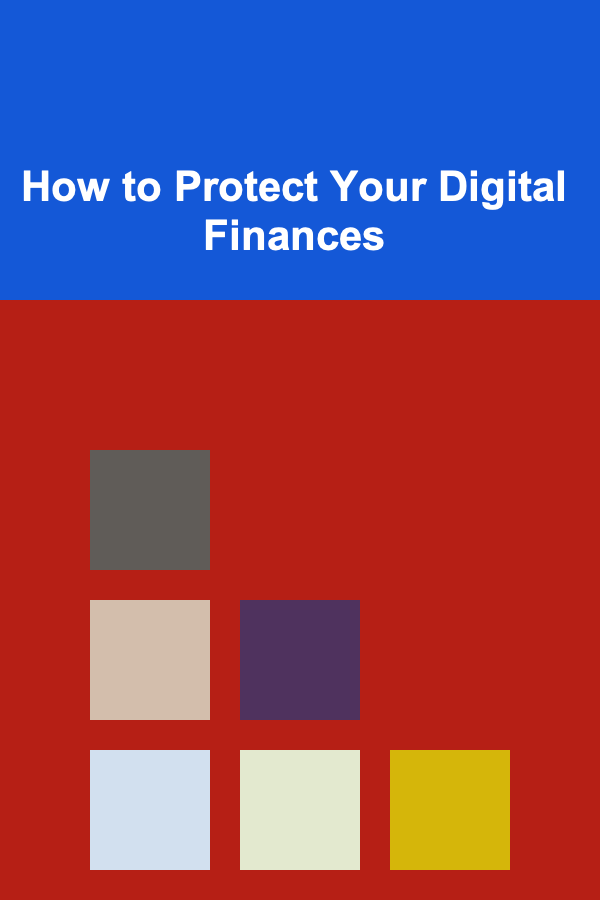
How to Protect Your Digital Finances
ebook include PDF & Audio bundle (Micro Guide)
$12.99$10.99
Limited Time Offer! Order within the next:

In today's interconnected world, digital financial transactions are becoming increasingly common. Whether it's banking online, shopping via e-commerce platforms, or investing in cryptocurrencies, digital finance offers convenience and accessibility. However, this shift also exposes users to a variety of risks, including cyberattacks, fraud, identity theft, and data breaches. As a result, protecting your digital finances has never been more critical.
In this article, we will explore the various threats to digital finances and outline practical strategies you can employ to protect your financial assets online. From using strong passwords to understanding the importance of two-factor authentication, we will dive into essential tools and habits that can safeguard your digital financial life.
The Risks of Digital Finances
Before diving into the protective measures, it's essential to understand the risks that come with managing your finances online. These risks are constantly evolving, and new vulnerabilities emerge every day.
1. Phishing Attacks
Phishing is one of the most common forms of cybercrime. It involves the use of fake websites, emails, or phone calls to deceive you into sharing sensitive information, such as account numbers, passwords, or Social Security numbers. Hackers impersonate trusted institutions like banks or payment processors, creating a sense of urgency to manipulate victims into acting quickly without thinking.
2. Data Breaches
A data breach occurs when a company or institution's security is compromised, leading to unauthorized access to sensitive information such as bank account details, credit card numbers, and personal identification data. In the aftermath of a breach, hackers may use this information to steal funds, open new accounts in your name, or commit fraud.
3. Malware and Ransomware
Malware is malicious software that infects your devices, allowing cybercriminals to access personal information or financial accounts. Ransomware is a specific type of malware that locks your files or computer and demands payment (usually in cryptocurrency) to unlock it. Both types of threats are particularly dangerous because they can be hidden in seemingly harmless files, attachments, or websites.
4. Identity Theft
Identity theft is a growing concern in the digital age. Cybercriminals can steal your personal information and use it to impersonate you, access your financial accounts, or open new ones. If someone gets hold of your identity, the consequences can be disastrous, leading to financial losses and significant damage to your credit score.
5. Unsecured Wi-Fi Networks
Using public Wi-Fi networks, especially when accessing your financial accounts, poses significant risks. These networks are often unsecured, meaning that hackers can easily intercept your communications, potentially accessing your personal and financial information.
6. Social Engineering
Cybercriminals sometimes use social engineering tactics to manipulate individuals into giving up sensitive information. This may involve manipulating a victim's emotions or leveraging information gleaned from social media platforms to create a sense of trust.
How to Protect Your Digital Finances
Now that we understand the various threats to digital finance, let's focus on practical steps you can take to protect your financial assets and personal information online.
1. Use Strong and Unique Passwords
The first line of defense against cybercriminals is a strong password. Weak passwords are an easy target for attackers, so it's essential to create passwords that are hard to guess.
- Avoid common passwords: Don't use simple or easily guessable passwords like "123456," "password," or your date of birth.
- Use a mix of characters: A strong password should include a combination of uppercase and lowercase letters, numbers, and special characters.
- Length matters: Aim for passwords that are at least 12 characters long.
- Don't reuse passwords: Each account should have a unique password to prevent a security breach on multiple platforms if one account is compromised.
A password manager can be an invaluable tool here. It helps generate and store strong, unique passwords for all of your accounts, reducing the risk of forgetting or reusing passwords.
2. Enable Two-Factor Authentication (2FA)
Two-factor authentication (2FA) adds an extra layer of security to your accounts. Instead of relying solely on a password, 2FA requires a second form of verification---such as a one-time code sent to your phone or generated by an authenticator app. This means that even if someone steals your password, they still cannot access your account without the second verification step.
Many financial services and platforms offer 2FA as an optional feature. Always enable it, particularly for banking apps, cryptocurrency accounts, and e-commerce platforms.
3. Monitor Your Accounts Regularly
Frequent monitoring of your bank accounts, credit card statements, and investment portfolios is essential to detecting any unusual activity. Most financial institutions allow you to set up alerts for transactions, so take advantage of this feature to stay informed about any charges or transfers.
- Report suspicious activity immediately: If you notice anything unusual, contact your financial institution immediately. The sooner you report it, the more likely it is that any unauthorized transactions can be reversed.
- Review credit reports: In addition to monitoring bank and credit card accounts, it's important to regularly check your credit report for any signs of identity theft or fraud.
4. Use Secure Connections
When conducting any financial transactions online, always ensure that you are using a secure connection. Look for the "https://" in the URL and a padlock icon next to the website address. This indicates that the website is encrypted and that your information will be transmitted securely.
Avoid accessing sensitive financial information over public Wi-Fi. If you must use a public network, consider using a Virtual Private Network (VPN) to secure your internet connection. A VPN encrypts your internet traffic, making it much harder for cybercriminals to intercept your data.
5. Beware of Phishing Scams
Always be cautious when receiving unsolicited emails, phone calls, or text messages asking for sensitive information. Legitimate companies will never ask you to provide personal details through these channels.
- Verify the source: If you receive a suspicious email, don't click on any links. Instead, go directly to the website by typing the URL into your browser to verify if the request is legitimate.
- Check for red flags: Look for signs of phishing attempts, such as poor grammar, generic greetings (e.g., "Dear customer"), or a sense of urgency urging you to act quickly.
6. Update Your Software Regularly
Software updates often contain important security patches that protect your devices from new vulnerabilities. Make sure that your operating system, antivirus software, and applications are up to date with the latest versions and patches. Enable automatic updates whenever possible to ensure you are protected against the latest threats.
7. Install Anti-Virus and Anti-Malware Software
Protect your devices from malicious software by installing reputable anti-virus and anti-malware software. These programs can help detect and remove malware, preventing it from accessing your financial accounts and other sensitive information.
Additionally, be cautious when downloading files or clicking on links from unknown sources, as they may contain hidden malware.
8. Protect Your Devices with Encryption
Device encryption is a security measure that makes your data unreadable to unauthorized individuals. This is especially important for laptops, smartphones, and tablets, as these devices often store sensitive financial information.
Many modern operating systems, such as Windows and macOS, have built-in encryption features. Enable full disk encryption to protect your data in case your device is lost or stolen.
9. Be Cautious with Public Wi-Fi
Public Wi-Fi networks are notorious for being unsecured, which makes it easier for hackers to intercept your data. When accessing your digital financial accounts, always avoid using public Wi-Fi unless absolutely necessary.
If you must use public Wi-Fi, connect through a Virtual Private Network (VPN). A VPN ensures that your connection is encrypted, even on unsecured networks.
10. Shred Physical Documents
While most of us focus on digital security, physical security is just as important. Ensure that any documents containing financial information (e.g., bank statements, tax returns, credit card offers) are securely disposed of. A shredder can effectively destroy sensitive materials, preventing identity thieves from accessing your personal data.
11. Educate Yourself and Others
Lastly, one of the most important steps in protecting your digital finances is education. Stay informed about the latest security threats and digital finance trends. Follow trusted sources for cybersecurity news and be proactive about learning how to defend yourself against new types of scams and attacks.
Share this knowledge with friends and family members, especially those who might not be as tech-savvy. Helping others stay safe online contributes to a more secure digital financial environment for everyone.
Conclusion
Protecting your digital finances is crucial in today's world, where financial transactions are increasingly taking place online. By following best practices, such as using strong passwords, enabling two-factor authentication, monitoring your accounts, and staying vigilant against phishing scams, you can significantly reduce the risk of cybercrime. Additionally, being cautious with public Wi-Fi, keeping your devices secure, and regularly updating your software are all essential steps in safeguarding your digital assets.
While the digital financial landscape is rife with potential threats, implementing these strategies can go a long way in ensuring your personal and financial information remains secure. The more proactive you are in securing your online finances, the less vulnerable you'll be to cybercriminals and the better you'll be able to protect yourself in the ever-evolving digital world.
Reading More From Our Other Websites
- [Personal Care Tips 101] How to Lose Weight Without Giving Up Your Favorite Foods
- [Personal Care Tips 101] How to Make a Body Wash for Men
- [Home Pet Care 101] How to Choose Safe and Fun Toys for Your Pets
- [Digital Decluttering Tip 101] Top Apps and Tools for Seamless Contact Management
- [Organization Tip 101] How to Conduct a Home Inventory for Insurance Purposes
- [Personal Care Tips 101] How to Choose the Right Shaving Cream for Dry Skin
- [Survival Kit 101] How to Choose the Best Survival Kit for Beginners: A Complete Guide
- [Ziplining Tip 101] Eco-Friendly Thrills: Choosing Sustainable Zipline Tours for Green Travelers
- [Home Budget Decorating 101] How to Upcycle Old Furniture into Chic Pieces for Your Home
- [Organization Tip 101] DIY Rain Barrel Installation: Tips for a Successful Setup

Best Practices for Writing Copy for One-Page Websites
Read More
How to Achieve Effective Human-AI Collaboration with ChatGPT
Read More
How to Hang Holiday Lights Outside Your Home Without Overcrowding
Read More
How to Maximize Small Spaces with Creative Renovation Ideas
Read More
How to Invest in Reforestation and Afforestation Projects
Read More
Healthy & Creative Pasta Sauces: Beyond the Jar
Read MoreOther Products

Best Practices for Writing Copy for One-Page Websites
Read More
How to Achieve Effective Human-AI Collaboration with ChatGPT
Read More
How to Hang Holiday Lights Outside Your Home Without Overcrowding
Read More
How to Maximize Small Spaces with Creative Renovation Ideas
Read More
How to Invest in Reforestation and Afforestation Projects
Read More